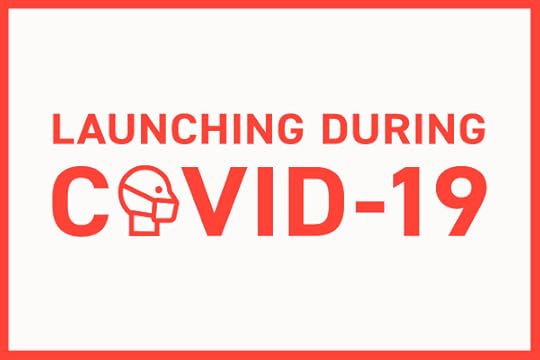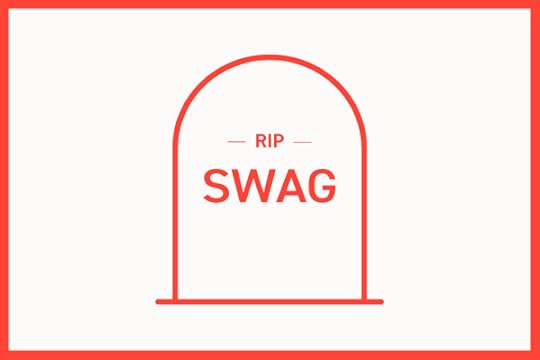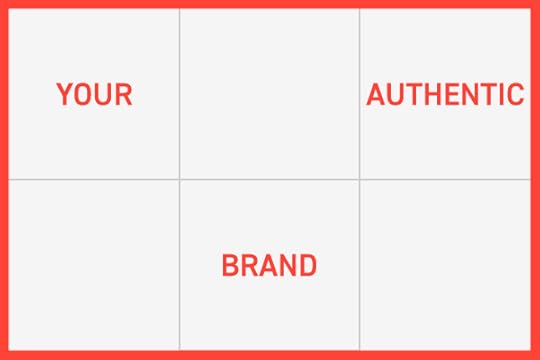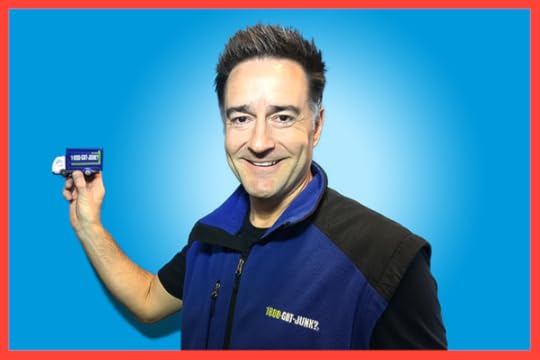Fabian Geyrhalter's Blog
July 16, 2020
How to Navigate Product Launches During COVID-19
Business Class from American Express interviewed me about the topic of launching during this pandemic.
The article outlines 5 key points:
Communicate with customers.
Be mindful of messaging.
Put the customer—not the brand—first
Evaluate the risks vs. rewards of launching.
Know your customers.
Read the full story here.
January 20, 2020
Why You Should Give Away Your Product (And Why Swag Is Dead)

Here is the thing about free stuff (“swag”) brands love to give away the minute they hit a certain threshold: It usually has zero impact on your bottom line yet it adds more waste into our landfills. Instead, gift your products (or services) to people when they least expect it when you (or any employee, at their own choosing) feel it is appropriate. It will instead leave a big impact, just not on the environment.
I write this post on my way to conduct one of my infamous brand workshops ; this one for a client in Amsterdam. Killing time at a restaurant at the airport terminal, I chatted it up with my waiter. When it was time to pay the check he handed me a 1-liter bottle of Evian, which I know they are usually selling at outrageous airport prices, while simply saying “for your flight.”
A few minutes later I was in line to board my first plane, to Chicago. I stood next to Jet Tila , a chef you may know from shows like Chopped or Iron Chef America. I did not recognize him at first since I was starring down at my phone like most everyone else. But a young girl sure did and she approached him – all smiles – inquiring if it really was him. He was very friendly and asked if she wanted a picture taken while her parents told him how much she enjoys his cooking and that she has been taking classes for years now.
Then he did what prompted this post: He told her that if her parents direct messaged him on social media with their mailing address he would send her a signed copy of his latest cookbook.
The bottle of Evian for the frequent traveler. The signed book for the next generation of fans. This is what every brand should do all the time: Give your product to the soon-to-be super fans, or to the ones you somehow disappointed. Not selfishly to influencers. Not because they ask for it. Give it unexpectedly to the ones that show you that they care about your brand, may that be in person, via a comment or a self-initiated post.
Instead of giving away your product to ten, send a box of your products to one.
Instead of giving away useless swag to one hundred, gift ten of your products to the ones who would appreciate and use it.
Yes, they will talk about it, but more importantly, they will never forget your brand.
Your brand growth will thank you; and so will the environment.
October 9, 2019
Why Instagram Is Your Brand’s True Homepage – And 3 Ways To Turn It Into A Lead Magnet

In my brand consultancy, we have a unique process of manifesting a brand’s newly crafted identity. Instead of rolling the design language out in great detail across every touchpoint of a client’s brand, we focus on only a few important pieces that will set the direction and thereby create the brand’s visual and verbal rules.
As part of this process (of showing how a brand can come to life), we recently started spending more time on creating newly branded Instagram accounts for our clients through an initial set of posts. We believe it is just as important, if not more important than the website. Why? Because when you see a company’s Instagram account, you get to know who they really are, what the company really cares about, and even more so, you get to meet the brand that exists today.
The beauty of Instagram is, quite obviously, the platform’s visual appeal. And Instagram for brands is exactly as the name implies: Instantaneous. That is also what most potential visitors seek: Instant gratification.
As of March 2019, Instagram business pages get over 1.5 billion visits a week, “but many entrepreneurs and startups are still ignoring Instagram as a major acquisition channel, mostly because they can’t add links to each post” says Andrew Lee Miller (who I worked with when helping Tinder and Match Group launch a new app).
Andrew, more widely known as AndrewStartups, a startup marketing expert who has led growth for three startup exits, states “Simply put, millions more people are now discovering brands organically through their Instagram account than their website, yet many companies are still spending tens of thousands of dollars optimizing their website, and not a dollar on their Instagram. Hiring a designer, a copywriter and a content strategist for your Instagram will absolutely pay off,” he argues. “It is more important to drive inbound traffic to – and convert on – ‘your new homepage,’ your Instagram page, than almost anywhere else on the web.”
If you are worried about keeping up your account and posting like a true millennial, there is some good news, which should come as a relief: Having a beautifully designed and distinctly on-brand Instagram page that efficiently illustrates your brand, your values, your culture, and your value proposition is what matters to leave a brand impression. Not the forceful, half-hastily constant updates by your intern. Take a breath and start to think of your Instagram page as your up-to-date homepage.
Here are 3 tips from Andrew and myself on how to go about it:
1. Create a longterm, targeted outreach
…and “off-page” social media marketing initiatives that drive new followers to your page every day.
2. Craft an impressive branding and design aesthetic
…coupled with a distinct brand voice, one that is more natural and tongue-in-cheek than currently found on your traditional channels (Those should adapt to your new, authentic voice, eventually).
3. Add a strong call to action
…in the bio with a link that converts. Share something valuable like an offer, a competition, or a free piece of content (white papers, anyone?) that will draw visitors further towards your brand.
It’s time to respect a channel that will instantaneously provide an up-to-date overview of your brand at its most authentic self. Not only that, but you will be able to sit back and watch leads come in from a source you least expected.
February 20, 2019
How Brian Scudamore, Whose Brands Are Making A Million Dollars A Day, Leads With Brand Thinking

An edited version of this interview was first published in my column on Grit Daily on 02/19/19.
I devoted my professional career to branding, from authoring books on the subject, to holding workshops and deriving brands through my consultancy, I live and breathe branding. Yet, when I sat down with serial entrepreneur Brian Scudamore, who I met when we were both mentoring at Guy Raz’s How I Built This Summit, I changed seats and had Brian share brand advice instead of myself.
Brian just released the book WTF (Willing to Fail): How Failure Can Be Your Key to Success and is making a splash in the business world. And that is mainly because he knows a thing or two about how to build a brand as he has started a business in college which today brings in an average of a million dollars a day (yes, you read that correctly!) and he is on the path to becoming a billion dollar company.
Brian Scudamore is a serial entrepreneur and author who has always taken the road less traveled. At just 19 years old, he pioneered the industry of professional junk removal with 1-800 GOT-JUNK, turning a chore people avoid into an exceptional customer service experience, changing the narrative of an entire industry in the process. When he ran out of new markets to expand to he scaled the business into three more home service brands under the O2E brands umbrella: WOW One Day Painting, You Move Me, and Shack Shine.
In between appearances on Oprah and Dr. Phil, and on the morning where he made it onto the home page of CNN.com, little me was fortunate to score time on his schedule to talk about branding, culture, and naturally about failures in the journey of an entrepreneur.
How do you get into that mindset of embracing failures? It’s so easy to say ‘fail forward,’ but most entrepreneurs are extremely driven, many have a ginormous ego and they often take failures very personally. How do you run towards failure with open arms?
So I’ve learned to ask myself one question in this journey. When I am failing, when I am having a difficult moment, when I am feeling depressed, whatever is going on that seems and feels like a failure, I ask myself one powerful question: What’s one potentially awesome thing that can come from this tough situation? And I start to brainstorm and sometimes I create a big list, and I go wow, thank goodness, this is exciting! How awesome that I am failing, because look at all these amazing things that can happen as a result of this learning. I think it’s a perception. I think that people need to really, really look at why is this failure happening and trusting that you’re in the right place at the right time and that while the mistake might hurt, it is going to get you to a better place if you so choose.
What was a ginormous brand fail that you went through with your venture?
I think one of the biggest ones was my first big flop. I had eleven employees, and they say one bad apple spoils the whole bunch. So I end up getting rid of my entire company. I have nine bad apples, and I sat down with them, and I said guys, I gotta let you know that I think I found the wrong people. I haven’t treated you right. I haven’t given you the love and support you need to be successful, and I’m making a tough decision here, but we’re gonna part ways. So I went from a company of twelve, myself and eleven, down to one. It was just me hauling junk. It was just me answering phones and trying to rehire. But I learned a valuable lesson from that failure that your very first employee has to be amazing because that person is going to spread the culture, the vibe, and the feeling of the business and that you need to really build on finding the right people and treating them right, and it’s made a huge difference. I look at our company of over five hundred people today and how amazing for us to feel so proud about the type of culture we have. It would have never have happened if I hadn’t made some of the mistakes I did.
Let’s talk about company culture a bit because I’m a firm believer that if done right, any startup should invest time and energy into creating a strong culture that can basically serve as the platform upon which everything else can be built. How important are core values to you?
Jim Collins wrote a book called Good to Great, one of my favorite books, and he said you’ve got to have values. It doesn’t matter what they are as long as they’re your values. So we went and took a little retreat to Bone Island, a little island near our office, and I said to my team at the time, maybe fifteen years ago, I said what are our values? What words can describe who we are, not who we want to be or who we are trying to be, but who we are today? What are those words? We took Post-It notes, we put them all up on these big windows, and we grouped all four hundred Post-Its with different words into four distinct categories: Passion, Integrity, Professionalism, and Empathy. And when we looked at those words they made the acronym of PIPE. It turned into this interesting tool around ‘the junkyard,’ our head office, where we would say to people: “I don’t know if that decision was very PIPE?,” or “I don’t know if that behavior was very PIPE. It’s not in line with our values.” And so values can’t just be a poster on a wall. Values have to be something that you hold your team, your people, accountable to and you hold yourself accountable to. If you’re not displaying passion, if you’re not displaying integrity, how can you take a look at yourself in the mirror and say what do I need to change? Let me be vulnerable and admit my mistake and then let me make sure that we are living, all of us, each and every day, by our values.
With building a franchise there is very tight brand management and brand stewardship involved, but equally as important is consistent brand design. What are some of the key steps that you had to go through to create a platform of tight brand rules and guidelines that also empower franchise owners a little bit, rather than solely restrict them?
I sat down and I read a book called The E-Myth by Michael Gerber. Michael and I have become friends. He is eighty-two years old. He wrote my favorite book on the planet and what the book talks about is people don’t fail, systems do. Take everything in your business, and it doesn’t matter if you’re running a brand agency, or a junk removal company, take everything you do and write down on one page what’s that one best practice and how would you teach someone else to do it? So how do you load a truck, how do you answer the phone in the call center and what’s the introduction? What’s that high energy and how do you talk to the customer? How do you market the business? How do you do your accounting? Every single piece of the puzzle has to be down on one page simplified. Here are the best practices and steps. You start with the right recruiting systems to find the right people, the right training systems to make sure that they’re trained properly, and you’ve got good people doing the right stuff and then the operating systems to keep them great. If you think back to when I fired that entire team, a team with eleven people, the biggest missing system was not those people. They didn’t fail, it was me failing because I didn’t have the right recruiting systems and then I didn’t have the right training systems and so it all kind of compounded in a massive failure, but it taught me and inspired me to end up finding that book not long after to really set up the processes in my business. If you’re trying to build a franchise, franchise brands all they are is proven recipe. A recipe that you can replicate that others can follow with the same success that you’ve had.
Especially with the junk business, you have to give instructions on how to change the narrative and change customer behavior to embrace the company of a franchisee as a brand rather than just another junk hauling man. How did you go about that? A lot of it was great uniforms and exceptional service, but how did you start as a brand, start talking about junk in a way where people felt like oh, 1-800-GOT-JUNK is an actual brand and not just local people who are driving around picking up my junk?
I think it was just years and years of consistency of the blue and green 1-800- GOT-JUNK brand and logo. Our trucks parked as massive billboards across every city that we operate in. It was the PR. All these things that continued to happen, it was building that press engine. It was building that consistency of the brand and that people wanted to be a part of the winning story. Our success has helped, but these overnight success stories as they say, sure take a long time. This wasn’t something that just happened in a year or two years, next month will be our thirtieth anniversary as a company.
You are a brand genius. You have done more than most people will ever do with one brand. What does branding mean to you?
Branding to me is a look and feel, a connection. Think of a person. You look at Oprah Winfrey, the way she dresses, the personality, the energy she’s got, her intelligence, the way she can connect with human beings on humanity. She is a great brand. Businesses have to do the same thing. How do you look? How do you act? Your values, what’s the brand feel like and what makes you so special and how do you differentiate yourself from anyone else in the world? Look at brands, here in front of me I’ve got my iPhone. Some people have an Android device. Both are great, both are brands. They’re very, very different and they appeal to different people for different reasons. I think that’s the key. it is just understanding that a brand is a feeling, a look and feel and how do you strategically create it in the right way?
What in your eyes is the most important part about branding that any startup should invest in getting right in the beginning? What is this one thing with your brand you have to get right in the beginning?
I think the one thing is just deciding what the brand will look and feel like and stick to it. Just really be consistent. Is McDonald’s the greatest looking logo in the world? Eh, the colors don’t appeal to me, but you know what they’ve done exceptionally well? They’ve been consistent over time, they have not strayed from their brand look and feel. So, I think it’s more important just to pick something and go, you know what, we are going to be proud, we’re going to be all in and stick with it.
June 30, 2018
5 Ingredients of a Strong Brand Foundation
If we think of your new brand as a building, the Brand Platform is the foundation upon which the construction takes place. If the foundation is strong and well considered, anything built on it has a higher chance of being equally sturdy. Too often, new brands rush to create a visual identity before having a firm Brand Platform in place, essentially putting a beautifully designed cart miles before the horse. Before your chosen design firm begins any work, you want to have a keen understanding of your new brand’s benefits, marketplace, target audience, and personality.
Download our free white paper to learn about:
Why it Matters
Constructing a Philosophy
Crafting a Personality
Discovering how you Differentiate
Identifying your Ideal Audience
Creating a Positioning Statement
June 29, 2018
Brand Architecture Strategies for Sustainable Brand Development
Launching a new brand without a strategic growth plan in place is like launching a kayak into a river without a paddle. You will not be able to forge ahead on a deliberate path without something to help guide you. A strategic plan for a Brand Architecture structure can help successfully guide the growth of your company as it expands into a web of brands, either built from the ground up or acquired into your portfolio.
Download our free white paper to learn about:
Why it Matters
Strategy Option A: House of Brands
Strategy Option B: Branded House
Top 3 Considerations for your Brand Architecture Strategy
June 28, 2018
How to Name your New Brand Successfully
Quite possibly, your organization’s greatest asset—the name of your new brand—will be with you for many years to come. It will become the launchpad from which all the other elements of your brand will spring, including potential sub-brands in the future. It sets the overall tone for your organization or product. Once a name has been selected and implemented, it is an expensive and disruptive undertaking to go through the process of changing that name. This is why it is so important to get it right the first time.
Download our free white paper to learn about:
Characteristics of a Great Name
Types of Brand Names
Selecting the Final Name
Trademarks
Megatrends, Trends, and Fads
June 27, 2018
How to Match Your New Brand Name with an Appropriate Domain Name
Naming your brand successfully (see our on this topic) and formulating your domain name go hand in hand. Every startup has different needs when it comes to domain ownership. Is owning your .com domain outright the only way to go? Or are there other ways you can have success with a creatively modified domain? Even if you have already answered these questions, factors such as domain availability, pricing, and trademark rights will all influence your final decision. In this white paper we offer a personalized guide to help you make strategic and informed decisions as you go through the process of choosing your new domain name.
Download our free white paper to learn about:
Branding your domain name
The process of choosing a domain
Purchasing a domain from an existing owner
What to do when the .com domain name for your brand is unavailable
How much money is a .com domain worth?
Alternatives to “brand.com” ownership
June 26, 2018
How to Gain Swift Stakeholder Buy-in During the Early Stages of your Brand Creation
Just as “no man is an island,” no entrepreneur or CMO exists in a vacuum. We naturally seek the advice of our coworkers, friends, family, and mentors. Validation and constructive criticism are crucial in developing a brand. However, one can easily upset this delicate balance either by ignoring the counsel of others or seeking the opinion of everyone. This step in the process is a rather slippery slope, but we have devised some tips and tricks to save you time, money, and sanity.
An important issue that gets overlooked too often by entrepreneurs and CMOs is getting buy-in at the right times and from the right people. Appropriate timing and knowing whom to involve are key differentiators between smooth sailing with a set destination and being adrift with no land in sight (as it pertains to your launch).
June 25, 2018
Creating Brands with a Purpose – When Social Impact turns into Profit
As the consumer market becomes increasingly saturated with competitive product and service offerings, branding is emerging as a key differentiator for prospective consumers. Thanks to a growing number of digital channels that allow consumers to interact with brands, consumers have the opportunity to be well-informed before they make a purchase. The most recent Edelman GoodPurpose study, which “explores consumer attitudes around social purpose, including their commitment to specific societal issues and their expectations of brands and corporations,” supports the notion that consumers care about how brands address social issues. Fostering a win-win relationship between business and the greater community is the ultimate goal of creating a brand with a purpose.
Download our free white paper to learn about:
Succeeding with Purpose
Lessons in Creating a Purpose-driven Brand from Birth: The TOMS Case Study
Lessons in Strengthening a Brand by Adopting a Cause: The Ben & Jerry’s Case Study



